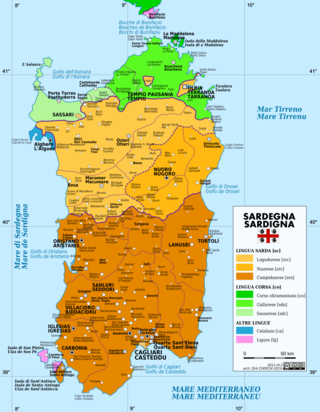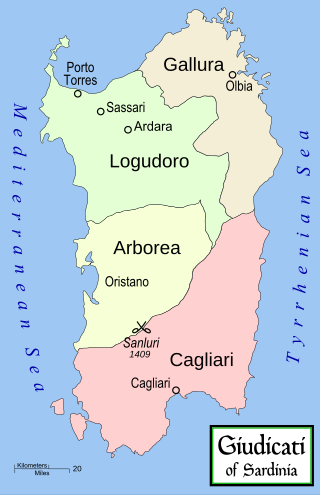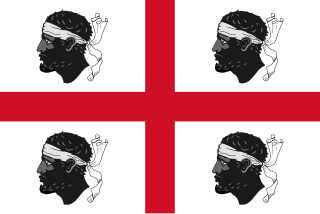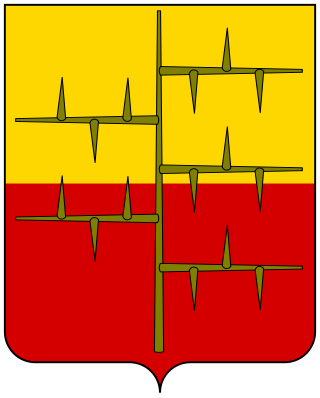Related Research Articles

Sardinian or Sard is a Romance language spoken by the Sardinians on the Western Mediterranean island of Sardinia.

Archaeological evidence of prehistoric human settlement on the island of Sardinia is present in the form of nuraghes and other prehistoric monuments, which dot the land. The recorded history of Sardinia begins with its contacts with the various people who sought to dominate western Mediterranean trade in classical antiquity: Phoenicians, Punics and Romans. Initially under the political and economic alliance with the Phoenician cities, it was partly conquered by Carthage in the late 6th century BC and then entirely by Rome after the First Punic War. The island was included for centuries in the Roman province of Sardinia and Corsica, which would be incorporated into the diocese of Italia suburbicaria in 3rd and 4th centuries.

The Judicates, in English also referred to as Sardinian Kingdoms, Sardinian Judgedoms or Judicatures, were independent states that took power in Sardinia in the Middle Ages, between the ninth and fifteenth centuries. They were sovereign states with summa potestas, each with a ruler called judge, with the powers of a king.
The Roman Catholic Diocese of Ampurias was a Latin suffragan Catholic bishopric in the north of Sardinia from 1070 till its suppression and merger with the Diocese of Civita-Tempio into the present Roman Catholic Diocese of Tempio-Ampurias.

The Kingdom of Sardinia, also referred to as the Kingdom ofSardinia-Piedmont or Piedmont-Sardinia during the Savoyard period, was a state in Southern Europe from the late 13th until the mid 19th century.

The Goceano is a historical and geographical region of center-north of Sardinia island, Italy. It covers a surface of 480 km2 and has a population of 13,000 inhabitants. It is located inside the Province of Sassari, the main urban centres are Bono, Italy, considered the traditional Goceano's chieftown, Anela, Benetutti, Burgos, Bultei, Nule, Esporlatu, Illorai and Bottidda.

The Sardinians, or Sards, are a Romance language-speaking ethnic group native to Sardinia, from which the western Mediterranean island and autonomous region of Italy derives its name.

The Perfect Fusion was the 1847 act of the Savoyard king Charles Albert of Sardinia which abolished the administrative differences between the mainland states and the island of Sardinia within the Kingdom of Sardinia, in a fashion similar to the Nueva Planta decrees between the Crown of Castile and the realms of the Crown of Aragon between 1707 and 1716 and the Acts of Union between Great Britain and Ireland in 1800.

Sardinian nationalism or also Sardism is a social, cultural and political movement in Sardinia calling for the self-determination of the Sardinian people in a context of national devolution, further autonomy in Italy, or even outright independence from the latter. It also promotes the protection of the island's environment and the preservation of its cultural heritage.

The literature of Sardinia is the literary production of Sardinian authors, as well as the literary production generally referring to Sardinia as argument, written in various languages.
The Battle of Lucocisterna was fought on the 29 February 1324, during the Aragonese conquest of Sardinia, between the army of the Crown of Aragon, in command of the Infante Alfonso IV of Aragon, son of King James II of Aragon, and the army of the Republic of Pisa led by Manfredi della Gherardesca, Count of Donoratico.

Hampsicora was a Sardo-Punic political leader and landowner of Sardinia, and the leader of the major anti-Roman revolt in the province of 215 BC.

Leonardo Alagon, even Alagón or de Alagón,, was the last marquis of Oristano (1470–1478).

The Marquisate of Oristano was a marquisate of Sardinia that lasted from 1410 until 1478

Sardinia's Day, also known as Sardinian people's Day, is a holiday in Sardinia commemorating the Sardinian Vespers occurring in 1794–96.

The Sardinian–Aragonese war was a late medieval conflict lasting from 1353 to 1420. The fight was over supremacy of the land and took place between the Judicate of Arborea -- allied with the Sardinian branch of the Doria family and Genoa -- and the Kingdom of Sardinia, the latter of which had been part of the Crown of Aragon since 1324.

Corrado Malaspina, was an Italian nobleman and landowner.
John Moulton Day was an American historian.

The Free Municipality of Sassari or Republic of Sassari was a state in the region of Sassari in Sardinia during the 13th and 14th centuries, confederated first with the Republic of Pisa as a semi-autonomous subject and later with the Republic of Genoa as a nominally independent ally. It was the first and only independent city-state of Sardinia during the early renaissance.

The Kingdom of Sardinia was a feudal state in Southern Europe created in the early 14 century and a possession of the Crown of Aragon first and then of the Spanish Empire.
References
- 1 2 Università di Cagliari. "Festeggiati i 50 anni di studi di Francesco Cesare Casula". www.unica.it (in Italian). Unica. Archived from the original on 13 April 2013. Retrieved 16 March 2011.
- ↑ Caria, Antonello (4 November 2020). "Esclusiva/ Francesco Cesare Casula: "Vi svelo le missioni svolte per Cossiga"". il Cagliaritano (in Italian). Retrieved 11 October 2022.
- ↑ Casula, Francesco Cesare. "Vogliamo rimettere in piedi la nostra storia rovesciata?". www.gianfrancopintore.net (in Italian). Gianfranco Pintore. Archived from the original on 1 August 2012. Retrieved 16 March 2011.
- ↑ Floris, Francesco. "Enciclopedia della Sardegna, Volume II" (PDF). www.sardegnacultura.it (in Italian). 2007 Editoriale La Nuova Sardegna S.p.A. p. 518. Archived from the original (PDF) on 14 November 2012. Retrieved 16 March 2011.